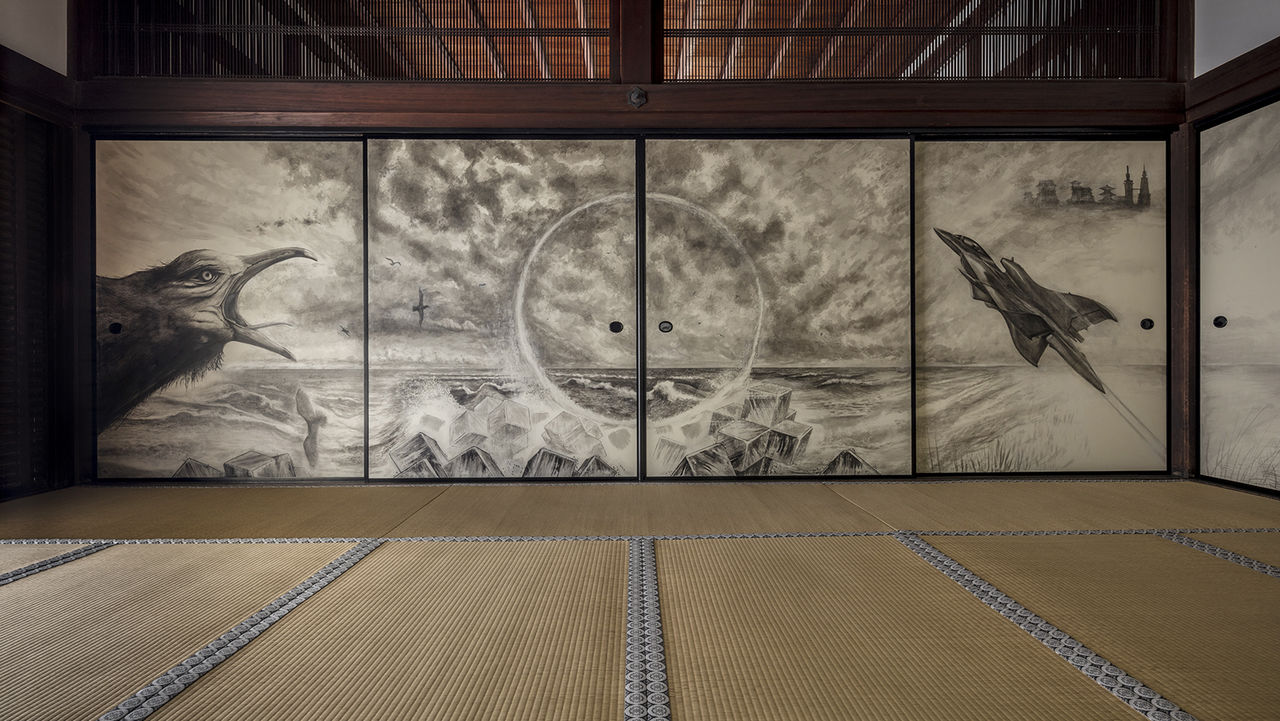
Yamaga Hiroyuki’s “Just Getting By” Takes Flight on the Sliding Doors of Kyoto’s Shinjuan
Guideto Japan
- English
- 日本語
- 简体字
- 繁體字
- Français
- Español
- العربية
- Русский
A Jet Fighter on a Temple Fusuma
The ear-splitting cry of a black-tailed gull pierces the sound of waves crashing against a breakwater. Out of the corner of one’s eye, one sees a jet fighter rocketing skyward. These two flying objects, bird and plane, frame a mysterious circular wave between them, with a choppy wintry sea providing the backdrop. The silhouette of a metropolis rising in the distant sky gives the impression that this is a world inhabited by humans. The title for this fantastic image: “Just Getting By.”
The Danna no Ma room of Shinjuan’s main hall previously contained fusuma paintings painted by Hasegawa Tōhaku, a painter deeply associated with the Momoyama period of the late sixteenth century alongside such historical figures as Sen no Rikyū, founder of the tea ceremony, and the military leader Toyotomi Hideyoshi. Yamaga Hiroyuki, principal of Gainax, the studio that gave birth to Neon Genesis Evangelion, was commissioned to create new images to appear where the Tōhaku ink-brush fusuma paintings had been previously. Yamaga took up residence in Shinjuan in autumn 2017 and began the work, which he finally completed in March 2018.
The scene continues on the four fusuma on the north side of the room, featuring a pine tree that hints at homage paid to Tōhaku. While differing to some degree from the light Tōhaku touch, it represents in full the technique of India-ink painting, in which everything is represented solely by ink tones. The branch of the pine tree, forcefully extending across the frame in a sinuously winding form, appears to be sheltering a girl dressed in thin clothes.
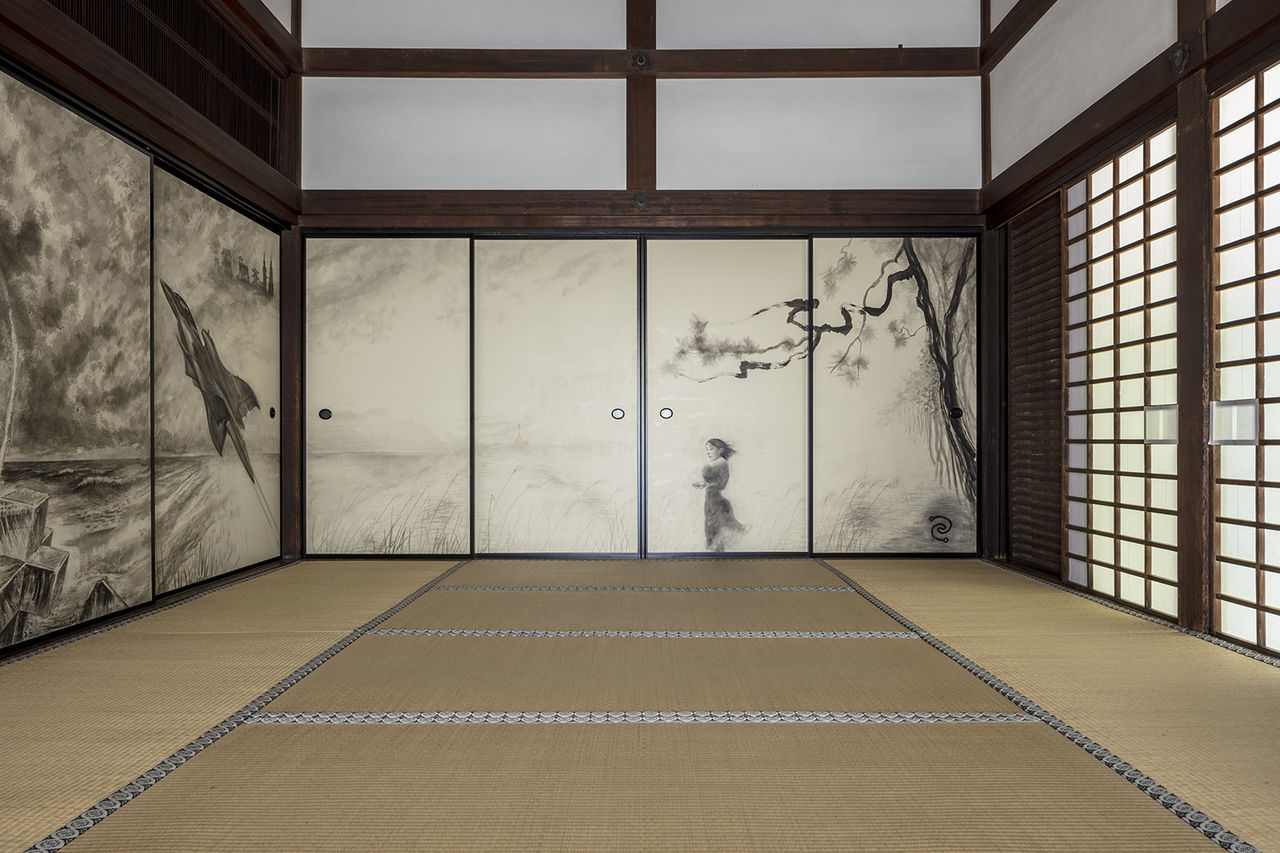 The fusuma paining on the north side of the Danna no Ma room.
The fusuma paining on the north side of the Danna no Ma room.
I first met Yamaga some five years ago, when I was in college. At the time, he said that while he might be an animator, he couldn’t draw—and indeed, he wasn’t even all that interested in drawing. Thus, he explained to me, he uses talented animators to make movies to keep himself employed.
When I heard that he was going to paint these fusuma illustrations, my immediate reaction was to ask him if he knew what he was doing. He offhandedly replied that he could draw if push came to shove.
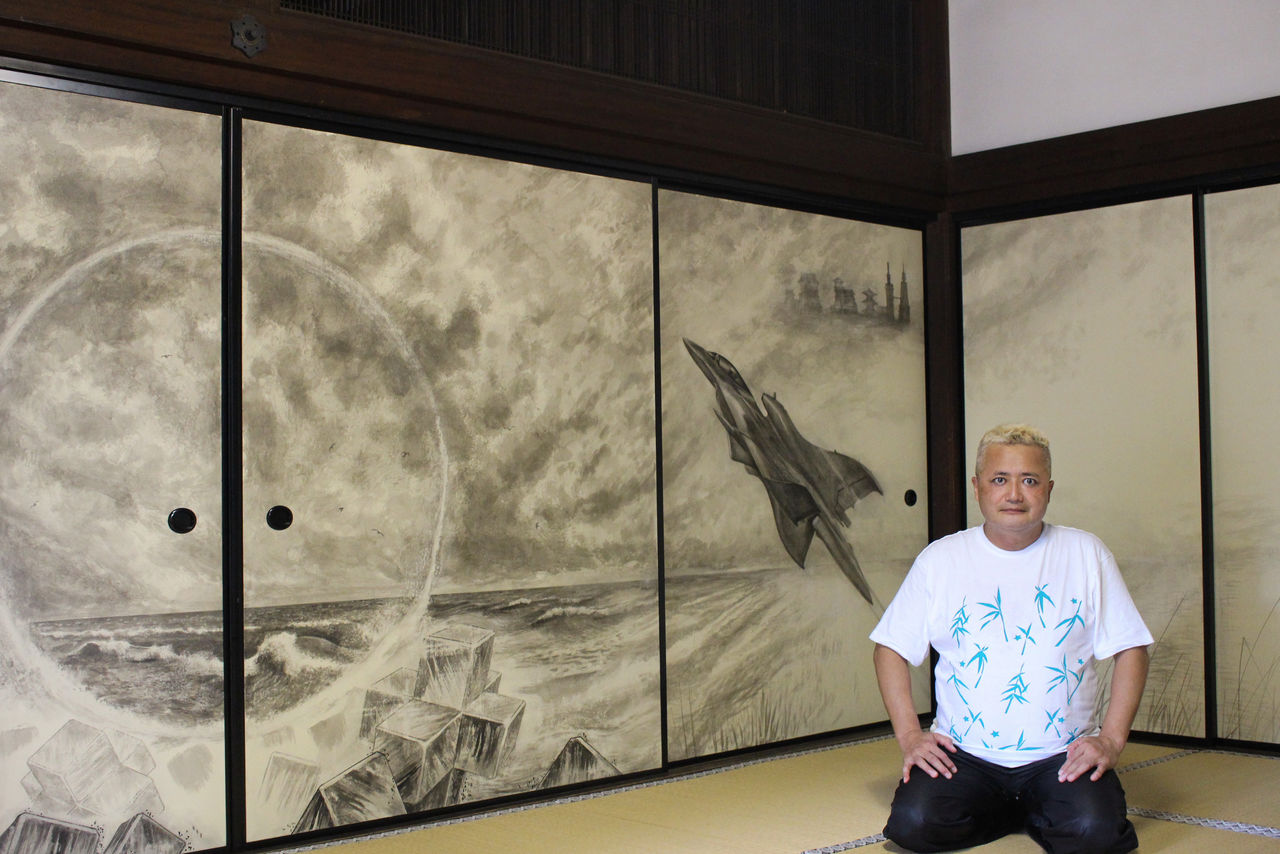 The artist sitting before his jet fighter. A metropolis can be seen high in the clouds to the rear.
The artist sitting before his jet fighter. A metropolis can be seen high in the clouds to the rear.
Asking a Non-Drawer for Art, the Zen Way
Yamada Sōjun, the temple superior of Shinjuan, asked Yamaga to do the fusuma paintings in an unusual manner.
Seeing Yamaga taking deep breaths at a collective Zen session, the superior perceived extraordinary samadhi—the meditative concentration that lets a Zen practitioner enter into a religious experience—and decided on the spot to commission him. This was despite the fact that the superior had never even seen an Evangelion work, let alone any of Yamaga’s illustrations. While this might seem a highly irresponsible decision, their dialogue was probably facilitated through communication based in Zen.
The superior’s intuition was on the mark. He persuaded someone to draw who had been resigned to not drawing for nearly 30 years. While those who knew him best were concerned about Yamaga taking on the task of creating fusuma illustrations, he and the temple superior gave no sign that they took any notice.
I had acquired a copy of Royal Space Force: The Wings of Honnêamise, Yamaga’s first film, in order to write this piece. When I subsequently showed it to the superior, he seemed impressed.
 The cry of this black-tailed gull seems almost audible in the presence of Yamaga’s painting.
The cry of this black-tailed gull seems almost audible in the presence of Yamaga’s painting.
From “Incident” to “Legend”
Released in 1987, Royal Space Force is an animated science-fiction film made by a group of Yamaga’s classmates from the Osaka University of Arts, including such eventual industry movers and shakers as Anno Hideaki, a cofounder of Gainax who would later make the Evangelion series. Yamaga says that with their long theatrical runs, these movies were something that shook up the anime industry, showing that a bunch of young amateurs could create SF anime of truly professional caliber.
In 1992, Gainax announced the concept of Aoki Uru, which was intended to be the sequel to Royal Space Force. The project that would become Neon Genesis Evangelion was launched thereafter, however, resulting in a quarter of a century passing with no further developments on Aoki Uru. Yamaga says that for his fusuma illustration, he has painted one scene of the worldview of Aoki Uru, the concept he has nursed all these years.
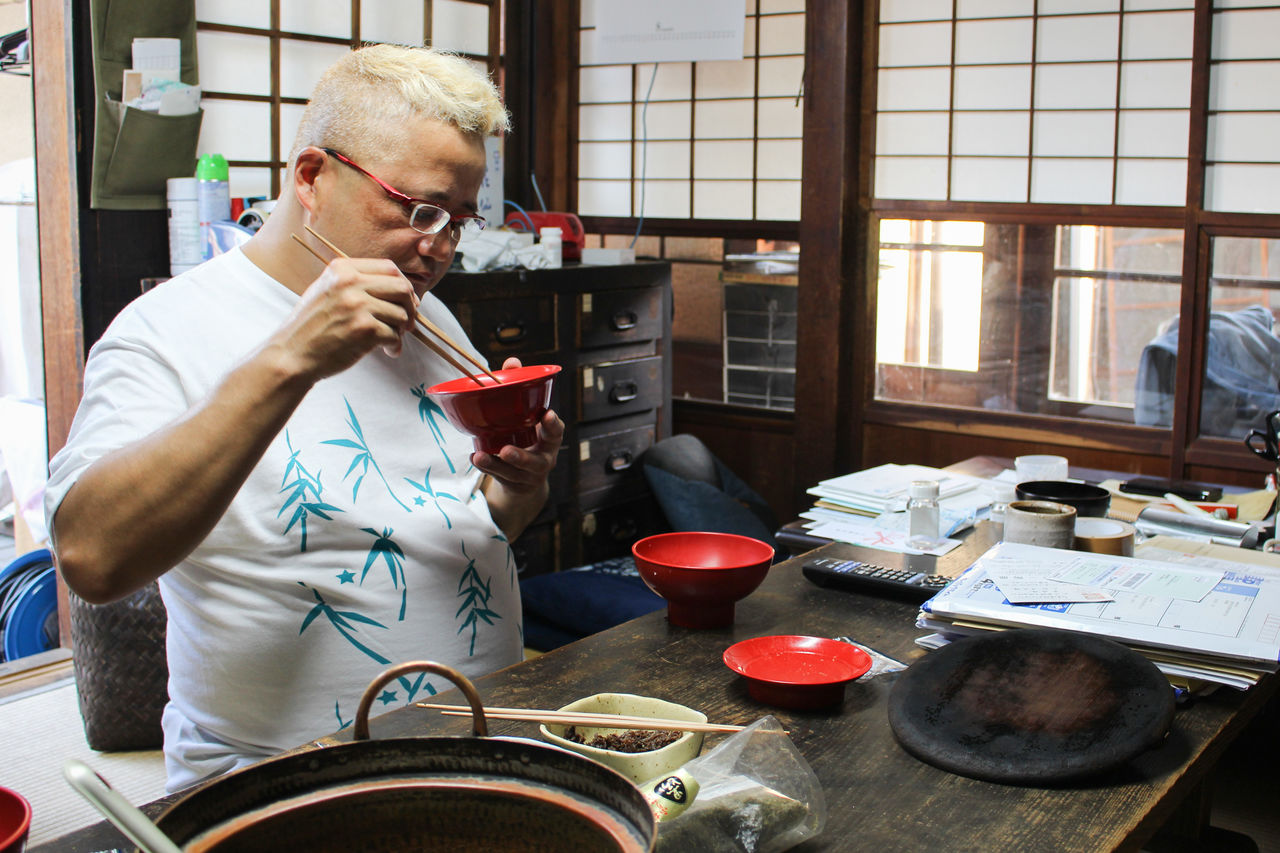 Yamaga having a meal at Shinjuan, where he resided temporarily, becoming a familiar sight to the resident students.
Yamaga having a meal at Shinjuan, where he resided temporarily, becoming a familiar sight to the resident students.
Perhaps recalling the time in his life when he dropped out of college to start a company and threw himself into making his first feature film, Yamaga seemed constantly happy, to an outside observer at least, during the six months or so that he resided at Shinjuan. Now over 50 years of age, he has seen the colleagues he worked with on the Gainax hits striking out on their own.
This fusuma illustration might be the engine that fires Yamaga up, however. There is a sense of it marking a turning point. The release of Aoki Uru after over 30 years would be yet another development to shake up the anime industry.
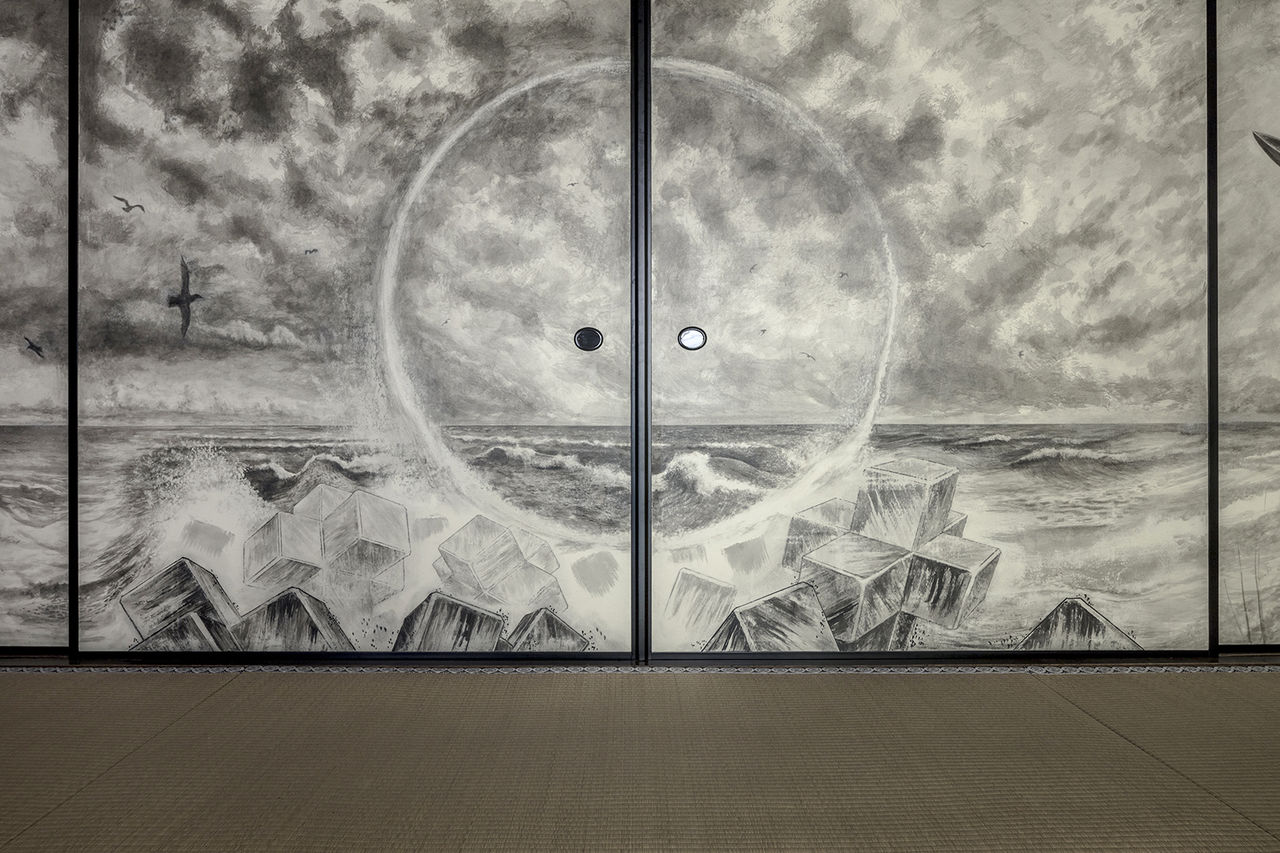 This mysterious circular wave gives observers a feeling of anticipation for Aoki Uru.
This mysterious circular wave gives observers a feeling of anticipation for Aoki Uru.
Related > New Art in an Old Setting: The Shinjuan Painting Project at Daitokuji, Kyoto
Daitokuji Shinjuan Special Viewing
- Dates: September 1 to December 16, 2018 (closed October 19–21)
- Hours: 9:30 am to 4:00 pm (last entry)
- Fee: Adults ¥1,200, junior high and high school students ¥600, ages 12 and under free (when accompanied by an adult). Note: preschool age children will not be admitted to the Tsūsen’in study or the Teigyokuken tea ceremony room.
- Access: from Kyoto station, take the Kyoto municipal subway Karasuma line to Kitaōji. Transfer there to Kyoto city bus routes 1, 101, 102, 204, 205 or 206 and get off at Daitokuji-mae. From there, 7 minutes on foot (total travel time about 35 minutes).
- Daitokuji Shinjuan special viewing website
- Crowdfunding website for Kyoto Shinjuan (Japanese language only)
(Originally published in Japanese. Photos of fusuma paintings by Asano Satoshi; photos of Yamaga Hiroyuki by Tsunoda Ryūichi.)